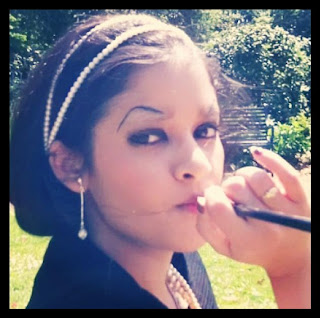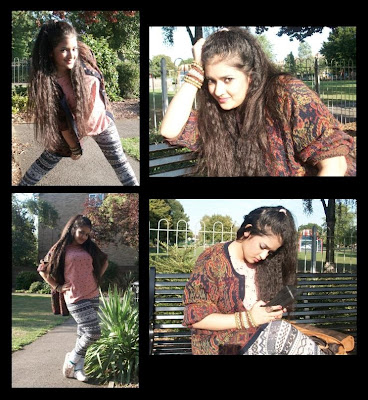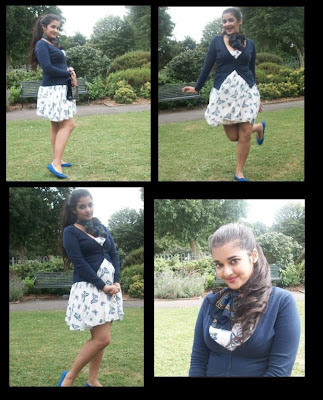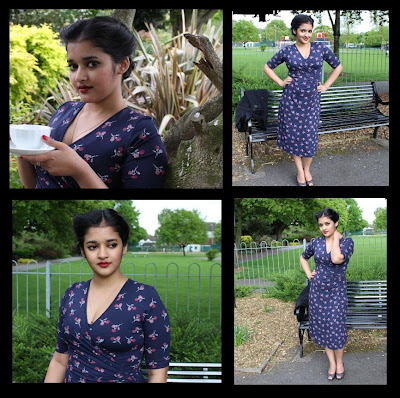Different political movements has affected women's fashion throughout time. Looking at the fashion trends from the 20th Century, we can see this...

1900s
In the year 1901, King Edward VII became King of England, taking over the throne from his mother, Queen Victoria.
As he led a very hedonistic lifestyle, consuming alcohol daily and giving little regard to those around him, King Edward had a turbulent relationship with his mother, who blamed him for the death of her husband, Prince Albert.
Queen Victoria mourned the death of Prince Albert. It was from that time onwards she wore only black.
The 1900s was a pivotal time for women in history; this was the beginning of the Suffragette Movement where women fought for the right to vote. As women made their voices heard, they also had a marked change in the clothes that they wore. Prior to the 1900s, women would wear tight corsets. They would start wearing the corsets at a young age, thereby training their waists to always stay trim. This meant that the waists would not grow to their full extent, causing a lot of health issues for the women at the time.
Around the 1900s was when women stopped wearing such tight corsets. They did continue to wear padding underneath their petticoats; this would give them fuller looking hips.
The fashion icon of the time were the Gibson girls. These were illustrations by Charles Gibson. The Gibson girls were older females, conservatively dressed, somewhat vulnerable in their appearance. Hair was worn in big pompadours, make-up was not used by the masses, the clothes were very conservative and shoes worn for practical purposes and not for fashion. The Edwardian lady took a lot of care over her appearance and would have a very good skincare regime in place and nails would be painted in a very neutral or clear colour.
Career opportunities for women were limited. Women were able to get an education but the roles open for them was housewife or school teacher. Alongside the fight to grant women the right to vote, there were demonstrations in the country for women to get fairer treatment in society.
1910s
The 1910s was a particularly bleak time for Britain; there was the sinking of Titanic, the passing of King Edward VII and then of course there was the great war, which later came to be called the First World War.
World War I took place when the Archduke of Austria, Franz Ferdinand was assassinated by Serbia. The war started in 1914 and ended in 1918. The King at the time was King George V, who was regarded as rather outstanding as he had cut down on the expenses and the extravagances of the monarch when Britain went into war. King George V also stopped drinking alcohol to encourage other people to do the same and thereby, reducing the number of drunkards.
Approximately 10 million people died during the war, which meant that there were a lot more widows and so, more ladies were seen to be wearing black. Before then, wearing black was considered highly inappropriate.
Whilst the men went out to war, the women were left to fend for themselves and their children. Women were no longer seen as the housewife or the teacher, but as the bread-winner and she finally had more responsibilities outside of the house.
As the war began, fashion had paused and the type of clothes that ladies would wear would be a lot more practical than the earlier days; waists were loosened, and the hem lines were shortened, revealing the ankles.
Designer Lady Duff Gordon, a Titanic survivor invented the slit-skirts. Coco Chanel, who did not become a major fashion sensation till the next decade also, played a minor part in the fashion world of the 1910s. She noticed that many of the ladies did not wear jewellery as they were expensive and so she started creating jewellery with less expensive material; and so for the first time, jewellery became affordable to the masses. Chanel also made some other accessories, such as fancy hats. So, the ladies of the 1910s would be seen to either wear their hair up in big pompadours or wear a stylish hat.
The fashion icons of the 1910s would have been British film actress Gladys Cooper and silent film actresses Lily Elsie and Peggy Kurton.
1920s
The 1920s was a revolutionary time for women's rights. In 1918 women finally won the right to vote after a lot of campaigning, protests and rallying. However, this privilege only extended to women over the age of 30. Men however, were able to vote if they were over the age of 21, unless they had fought in the war. In which case, they could vote from age 18. In 1928, women and men had the same rights when came to voting.
With feminism being at an all time high, fashion had changed remarkably since the pre-war era. Women became empowered and stopped wearing such form fitting clothes; the dresses were also a lot shorter. Hair was cut to a short bob. Women were adopting an almost androgynous look.
Coco Chanel became an iconic figure in fashion. She was the master mind behind the concept of the little black dress. Black was traditionally worn at funerals or by grieving widows. Vogue had published an illustration of a LBD created by Chanel and stated that it would become the uniform of the modern woman.
Major fashion icons of the 1920s also included American silent film actress Louise Brooks who was best known for her short bob and being married to Charlie Chaplin, silent film Clara Bow, who was thought to be the first 'it girl' and was often subject of any scandals, American actress and singer, Gloria Swanson, who was known for her quirky style and fashion flare. Swanson would often accessorise her outfits with jewellery, hats and feathers. And Zelda Sayre, who is known as the first American flapper. She was an American author and the wife of F. Scott Fitzgerald.
As well as embracing different fashion trends, the 1920s also saw women engage in activities that was traditionally thought of as a 'man's activity'. Women began taking up sports such as hockey and tennis. Women also began smoking.
Dancing became popular in the 1920s; this was following the broadway show, 'Running Wild'. The Charleston was the dance of the time.
The 1920's lady took a lot of time and care in getting ready. Thought went in to every part of the outfit from head to toe. Hair was styled to a short bob, dresses were loose and stopped at the knee and shoes were becoming more of a fashion item.
Ladies wore a lot more make up than they did previously. Eyebrows were shaved off and a thin, sad-looking line was drawn on. Fake eyelashes, invented by film director, D. W Griffith were commonly being worn. Lipstick was being worn, but only on the centre part of the lip, making a woman's lips appear smaller yet thicker. And as for the nails, the 1920's ladies only painted the centre part of the nails.
1930s
Britain saw a change of monarchy during the 1930s. King George V died in 1936 and the throne was then taken over by his eldest son, King Edward VIII. King Edward VIII abdicated his position as King in order to pursue a relationship with Wallis Simpson, who at the time was married to a business tycoon. In 1937, King George VI became King.
During the 1930s, Britain experienced a major economic crisis, known as 'the Great Depression'. Approximately 2.5million Britons became unemployed; the standard of living was at an all time low and many households were left without running water, gas or electricity.
To supplement their incomes a lot of couples would enter into dance marathon contests. These competitions would be about stamina and endurance rather than skill and technique. This meant that a single competition could last a few days. Couples would often fall asleep on each other. Popular dances during the 1930s included the jitterbug and tap and jazz was the most popular genre of music.
As many men lost their jobs, women had to seek employment to keep their household running. Dresses became more conservative; hem lines dropped and the sleeves and shoulders got bigger. Fashion at the time favoured outfits that would be wearable at the workplace. Ladies would wear dresses or a skirt and blouse.
Hollywood had an influence on fashion during the 1930s. Fashion icons of the time included Jean Harlow, Marlene Dietrich and Vivien Leigh.
Wearing make up was becoming more of the norm. Ladies would do a lot of contouring to give themselves prominent cheekbones and jawline, their cupid's bow would be accentuated and eyebrows were shaven and drawn on with a dramatic thin arch.
1940s
World War II started in 1939 and ended in 1945 when the then President of Germany, Adolf Hitler attacked Poland who had used some German soil pre-1914 to establish their nation.
As with World War I, a number of countries became involved, including Britain. The War had an affect on everyone in the country. Men went out to work and women stayed back to look after their households.
Unlike the First World War, where fashion was not given any priority, World War II was different. Ladies dressed up, partly to keep the morale high in the country and also because there were some strong fashion influences coming from Hollywood and Germany. German fashion influenced fashion houses in Paris, London and New York. In England, ladies would paint their nails and lips in red to match the red in the union jack. This was a sign of their patriotism at the time.
The 1940's lady was elegant and stylish. Her outfits were very sophisticated; she wore less make up than the ladies of the 1930s and the 1920s. Hair-dos were also very elegant while being practical at the same time.
Fashion icons during the 1940s include Veronica Lake, Ingrid Bergman, Hedy Lamarr and Rita Hayworth.
1950s
The 1950s saw a change in the monarchy; King George VI died in 1952 and Queen Elizabeth II came to the throne. To date, she is the longest reigning monarch in Britain.
Economically, there were a lot of changes in Britain. Resources were no longer scarce; people were finally enjoying some wealth and prosperity.
The 1950s saw redevelopment of the country and skilled workers from the Commonwealth countries were being employed. While this was helpful in rebuilding Britain, it also meant that there was a lot of racism in the country; this was the first time that people of different race, religions, cultures and ethnicities were living and working together.
The style of the 1950s was very much influenced by the rock and roll music and Hollywood. Women's fashion icons were Audrey Hepburn, Elizabeth Taylor, Marilyn Monroe and Grace Kelly while men took their influence from Elvis Presley and Jonny Cash.
Ladies wore bolder colours, experimenting more with lipstick colours. They would wear pink, maroon orange and red. This was far different from the style of earlier days.
The 1950s also saw youth culture wanting to be stand out from the older generations and have a style that was just theirs. Just think of the characters from Happy Days and Grease; the style of the grown up characters were noticeably different from that of the T-Birds, The Pink Ladies and the rest of the younger crowd.
1960s
The 1960s, is best known for non-conformity. The adolescent of the time was concerned with not conforming to tradition and ironically their rebellion created a subculture of people, who 'conformed' to a certain style. The 1960's also saw a period of consumerism, where people would buy things on hire purchase, eventually leading to the modern day credit card. One of the subcultures formed during the 1960s was the mod culture. The term 'mod' is short for modernist. Those who followed the mod subculture prided themselves on having a modern outlook on life, being trendy and fashionable. The 1960s has been dubbed as the 'Swinging Sixties' due to the somewhat promiscuous lifestyle of the young, who did not want to be part of the conservative way of living as their parents had. The birth control pill was created in the 1960s with the view to empower and liberate women. Women had more sex than ever before. With the increased amounts of sexual activity taking place, there were a lot of unwanted pregnancies and young girls would often have secret abortions. At the time, abortion in the UK was illegal. The 1960s gave rise to the mini skirts. Mary Quant, who at the time was a very influential designer was the brains behind the mini skirt.
Fashion icons of the 1960s included Twiggy, Audrey Hepburn, Bridget Bardot and Cher. Also with mini skirts, bikinis and Twiggy all being the rage; 'skinny' became vogue. Prior to this period figures like Elizabeth Taylor and Marilyn Monroe would have been considered the ideal shape for beauty. Females bodies now had a fashionable 'shape' and 'size'.
Ladies in the 1960s preferred wearing soft pastel colours. Hair and make up of this time is also very distinctive; ladies liked their hair and eyes big, bold and beautiful.
1970s
1970's Britain saw a new surge of feminism and fight for liberation.
Women were no longer going to work because they needed to, but rather because they wanted to. For the first time, women were able to work on their ambition and be in direct competition with men. Yet, women were being paid a lot less and were often being harassed and treated unfairly in the workplace. The Equal Pay and Sex Discrimination Act 1975 was brought into place to remedy this.
Domestic violence against women was finally recognised as a crime and in 1976, Britain passed the Domestic Violence Act.
The decade also saw Britain's first female prime minister, Margaret Thatcher. The 1970's women had become empowered and was ready to have her voice heard.
Racism was also being addressed in the 1970s. People began to embrace diversity. Black artists were rising in popularity. Artists such as Tina Turner, Diana Ross and the Supremes and of course the Jackson 5 (who had already made a name for themselves) helped bridge cultures further.
The style icons of the 1970s includes Farrah Fawcett, Jerry Hall and John Travolta. Women were adopting an androgynous style, while men were becoming relaxed about appearing masculine and would be seen sporting long hair and make-up.
Possibly due to the feminist movement, the 1970's, women only wore light wear much make-up and they kept their nails clean and hair was left long and straight. In the evenings, ladies may have worn some eyeshadows (or crayons as it was back then). The colour palette was very earthy so a lot of blues, greens and browns.
1980s
In 1979, Britain got its first female Prime Minister, Margaret Thatcher. She is best known for holding her position as Prime Minister for the longest period in the twentieth century, having been elected three times.
The 1980s saw Prince Charles marry Princess Diana, who welcomed their sons, Prince William and Harry.
Music was an instrumental part to the 1980's culture. This decade brought us MTV; it was an innovative idea at the time to have a channel dedicated to showing music videos 24 hours a day, everyday. Television shows were being watched regularly by the masses and shows such as Dallas, Bold and the Beautiful, Little House on the Prairie and Rosanne were popular in the 1980s. Movies were a big thing in the '80s. Film maker John Hughes produced hit shows such as Sixteen Candles, Pretty in Pink, The Breakfast Club and Ferris Bueller's Day Off.
The 1980s also saw the start of day time television, which brought about the beginning of the fitness craze.
Technology was getting more advanced in the 1980s and by 1985, the first mobile phone was invented. Mobile phones were nowhere near as advanced as the phones today are but definitely worth checking out. They were the size of a brick with very little battery life.
The style of the 1980's was big, bold and colourful. Fashionable ladies sported a perm while the trendy men wore a mullet
Power dressing became a trend, much of which was influenced by Margaret Thatcher and Princess Diana. The '80s was a time, when women were starting to progress in the workplace. Women needed to create a more dominant presence and so came the shoulder pads. Fashion icons of the 1980s included Brooke Shields, Demi Moore, Molly Ringwald, Joan Collins, Cindy Lauper and Madonna. The style of the '80s was very individualistic and people embraced having their own creative flair. Make-up was bold and colourful. Less was not more, more was more.
1990s
Towards the beginning of the 1990s, Margaret Thatcher lost her position as Prime Minister when her own Cabinet turned on her. She was followed by John Major, who was a cause for much scandal when word got out of his affair with Edwina Curry. Prior to this, John Major was known for his right wing ways and the promotion of family value.
The 1990s said goodbye to Princess Diana, who died in 1997 in a car accident in France. Her untimely death left many Londoners in a state of shock and the country spent a period of time mourning her loss. Princess Diana had an unusual funeral, where the public had gathered to say their final goodbye and Elton John had come to sing Candle in the Wind.
During the 1990's pop culture and media became even more popular and an integral part of everyday life. Beverly Hill 90210, Saved By the Bell, California Dreams, Fresh Prince of Belair, Blossom, Married with Children and of course the ever popular Friends were a massive hit in the 1990s.
Music was also very important in the 1990s. Boybands and girlbands was all over MTV and top of the pops.
The 1990s has been dubbed as a decade that 'rejected' fashion. The fashion of the time was very casual and grunge was very much favourite style. Just think of plaid shirts, leather jackets and denim. The 1990s was also the first time that people got creative with their nails and jewellery. Different colours were starting to become more available.
There were a lot of fashion influences in the 1990s. And the beautiful supermodels of the time, such as Cindy Crawford, Naomi Campbell, Claudia Schiffer, Christy Turlington, Kate Moss defined beauty standards.
2000s
The year 2000 was waited on with batted breath. People were nervous about the Millennium Bug (also known as the Y2K Bug) that would invade all our computer systems and eventually end the world. This was not the first time that people had predicted the end of the world, but it was probably the first time that anyone took this seriously.
While we can rejoice in the Millennium Bug not ending the world, the 2000s had its fair share of disasters. September, 11th 2001 saw the collapse of the Twin Towers after which, war broke out in Iraq and Afghanistan. Tony Blair was the Prime Minister of Britain at the time.
The 2000s saw a multitude of reality television shows that heavily influenced the culture of the day. Shows such as Big Brother, Come Dine With Me and Pop Idol to name just a few was popularised in the 2000s. Becoming famous was made easy; people no longer needed to have talent or drive. They just needed some sort of exposure.
Other shows that graced our TV screens included10 Years Younger, How to Look Good Naked, Gok's Fashion Fixes, What Not to Wear, You Are What You Eat. These shows were very focused on getting people to look a certain way while at the same were trying to tell us to embrace our natural looks, giving confused messages to the viewers.
Plastic surgery, including botox and getting fillers seemed to become a very easy thing to do in the 2000s. To avoid the hefty price tag associated with plastic surgery, many would go abroad to get some work done. This was heavily discouraged as people would not get the right after-care and this was a dangerous and a potentially fatal thing to do.
There were many style icons of the 2000s. Patricia Field was responsible for the wardrobes of Sex and the City and The Devil Wears Prada. Rachel Zoe, who was known for styling celebrities such as Lindsay Lohan, Nicole Richie and Mischa Barton. And of course, there were Sienna Miller, Kate Moss and Victoria Beckham.


























Comments